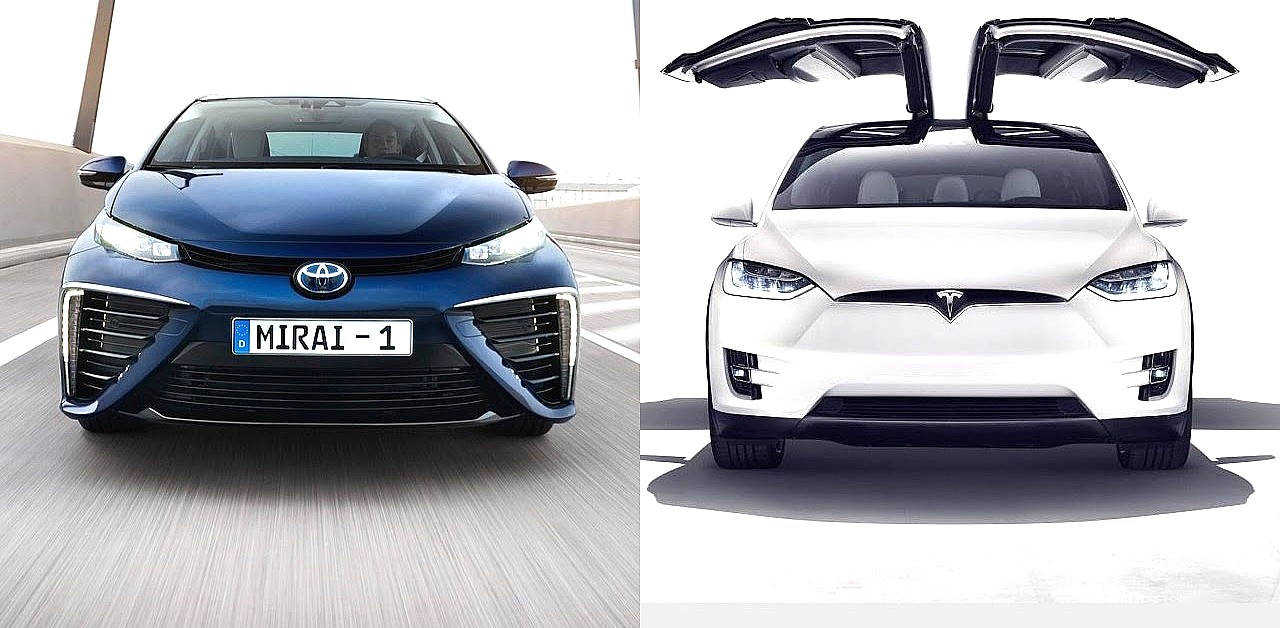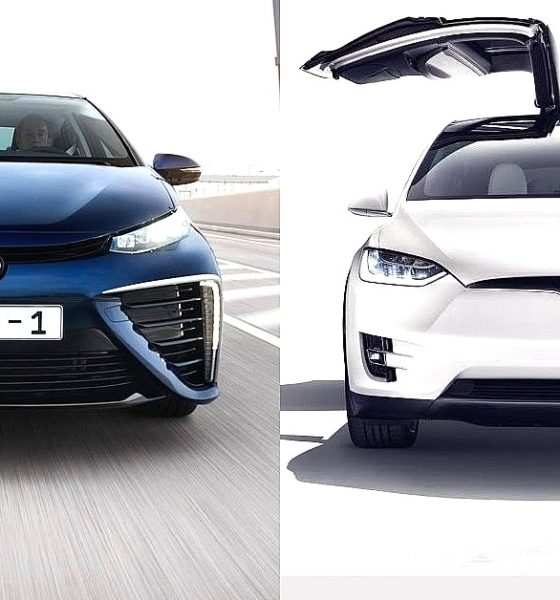

News
Tesla and other EVs will be overtaken by hydrogen cars by 2030, predicts auto expert
An automotive industry expert in Germany recently issued a bold dismissal of electric vehicles, declaring that EVs will be overtaken by hydrogen-powered cars. Before an audience, Dr. Felix Gress, head of Continental’s corporate communications and public affairs, argued that battery-electric vehicles represent poor value for money compared to diesel and petrol alternatives.
While Gress admitted that electric cars today are grabbing headlines and the attention of the automotive industry, the Continental executive predicted that the market would see shift to hydrogen in the next decade or so. “The fuel cell is not ready to kick in yet. By 2030, we’ll see that coming, especially in passenger cars that run long distances, or trucks… Fuel cell is not out of reach, I would say. The question is when it would kick in. We are working on that area, too,” the executive argued.
Gress added that electric cars will have difficulties finding acceptance among car buyers. “For the customers, it will be difficult to accept such a car in the market – you pay a higher price, you get less of a car, so it will be a tough sell,” he said, stating that based on Continental’s estimates, battery technology, and in extension, EVs in general, have their limits. “The battery technology, according to our estimations, has its limits. It doesn’t generate enough range for some people’s needs,” he added.
The Continental executive’s dismissive stance on electric cars run parallel to that of BMW’s director of development, Klaus Frölich, who recently stated that electric vehicles have no demand. During a recent round table interview in Munich, Frölich noted that “there is no customer requests for BEVs.” Responding to Europe’s Transport and Environment lobby group, which is pushing for the adoption of more electric cars, the executive fired back, arguing that BMW could easily flood the market with EVs, but no one will buy them.
“If we have a big offer, a big incentive, we could flood Europe and sell a million cars, but Europeans won’t buy these things. Customers in Europe do not buy EVs. We pressed these cars into the market, and they’re not wanted. We can deliver an electrified vehicle to each person, but they will not buy them,” the executive said.
Unlike Gress from Continental, Frölich instead argued for plug-in hybrids, which use both an internal combustion engine and an electric motor. He did note that BMW will still make pure electric cars for the US and China, but the company will concentrate its efforts to bring plug-in hybrids with 80 km (49 miles) of pure electric range. “PHEV gives them full freedom and 80 km of EV range,” he said.
It is quite surprising to see an executive from Continental, the same company that recognized the potential of Tesla as a player in the vehicle software market, completely dismiss electric vehicles as but a prelude to hydrogen propulsion. Hydrogen vehicles, after all, have been around for a while, and for the most part, they have stagnated. The Toyota Mirai, for example, has been around for years, but it has proven to be nowhere near as popular as the Prius, the company’s breakthrough hybrid car.
One thing where both Gress from Continental and Frölich from BMW seem to agree on is that electric vehicle batteries have limitations that could not be overcome. This is a flawed assumption, as batteries have continued to evolve over the years. Tesla, for example, has made significant breakthroughs in battery technology in recent years, as shown in the 2170 cells of the Model 3 Performance, which help the vehicle handle the extreme demands of closed circuit driving. By the end of Gress’ 2030 estimate for hydrogen cars, electric car batteries will most definitely not be the same as they are today.

News
Tesla starts showing how FSD will change lives in Europe
Local officials tested the system on narrow country roads and were impressed by FSD’s smooth, human-like driving, with some calling the service a game-changer for everyday life in areas that are far from urban centers.

Tesla has launched Europe’s first public shuttle service using Full Self-Driving (Supervised) in the rural Eifelkreis Bitburg-Prüm region of Germany, demonstrating how the technology can restore independence and mobility for people who struggle with limited transport options.
Local officials tested the system on narrow country roads and were impressed by FSD’s smooth, human-like driving, with some calling the service a game-changer for everyday life in areas that are far from urban centers.
Officials see real impact on rural residents
Arzfeld Mayor Johannes Kuhl and District Administrator Andreas Kruppert personally tested the Tesla shuttle service. This allowed them to see just how well FSD navigated winding lanes and rural roads confidently. Kruppert said, “Autonomous driving sounds like science fiction to many, but we simply see here that it works totally well in rural regions too.” Kuhl, for his part, also noted that FSD “feels like a very experienced driver.”
The pilot complements the area’s “Citizen Bus” program, which provides on-demand rides for elderly residents who can no longer drive themselves. Tesla Europe shared a video of a demonstration of the service, highlighting how FSD gives people their freedom back, even in places where public transport is not as prevalent.
What the Ministry for Economic Affairs and Transport says
Rhineland-Palatinate’s Minister Daniela Schmitt supported the project, praising the collaboration that made this “first of its kind in Europe” possible. As per the ministry, the rural rollout for the service shows FSD’s potential beyond major cities, and it delivers tangible benefits like grocery runs, doctor visits, and social connections for isolated residents.
“Reliable and flexible mobility is especially vital in rural areas. With the launch of a shuttle service using self-driving vehicles (FSD supervised) by Tesla in the Eifelkreis Bitburg-Prüm, an innovative pilot project is now getting underway that complements local community bus services. It is the first project of its kind in Europe.
“The result is a real gain for rural mobility: greater accessibility, more flexibility and tangible benefits for everyday life. A strong signal for innovation, cooperation and future-oriented mobility beyond urban centers,” the ministry wrote in a LinkedIn post.
News
Tesla China quietly posts Robotaxi-related job listing
Tesla China is currently seeking a Low Voltage Electrical Engineer to work on circuit board design for the company’s autonomous vehicles.

Tesla has posted a new job listing in Shanghai explicitly tied to its Robotaxi program, fueling speculation that the company is preparing to launch its dedicated autonomous ride-hailing service in China.
As noted in the listing, Tesla China is currently seeking a Low Voltage Electrical Engineer to work on circuit board design for the company’s autonomous vehicles.
Robotaxi-specific role
The listing, which was shared on social media platform X by industry watcher @tslaming, suggested that Tesla China is looking to fill the role urgently. The job listing itself specifically mentions that the person hired for the role will be working on the Low Voltage Hardware team, which would design the circuit boards that would serve as the nervous system of the Robotaxi.
Key tasks for the role, as indicated in the job listing, include collaboration with PCB layout, firmware, mechanical, program management, and validation teams, among other responsibilities. The role is based in Shanghai.
China Robotaxi launch
China represents a massive potential market for robotaxis, with its dense urban centers and supportive policies in select cities. Tesla has limited permission to roll out FSD in the country, though despite this, its vehicles have been hailed as among the best in the market when it comes to autonomous features. So far, at least, it appears that China supports Tesla’s FSD and Robotaxi rollout.
This was hinted at in November, when Tesla brought the Cybercab to the 8th China International Import Expo (CIIE) in Shanghai, marking the first time that the autonomous two-seater was brought to the Asia-Pacific region. The vehicle, despite not having a release date in China, received a significant amount of interest among the event’s attendees.
Elon Musk
Elon Musk and Tesla AI Director share insights after empty driver seat Robotaxi rides
The executives’ unoccupied tests hint at the rapid progress of Tesla’s unsupervised Robotaxi efforts.

Tesla CEO Elon Musk and AI Director Ashok Elluswamy celebrated Christmas Eve by sharing personal experiences with Robotaxi vehicles that had no safety monitor or occupant in the driver’s seat. Musk described the system’s “perfect driving” around Austin, while Elluswamy posted video from the back seat, calling it “an amazing experience.”
The executives’ unoccupied tests hint at the rapid progress of Tesla’s unsupervised Robotaxi efforts.
Elon and Ashok’s firsthand Robotaxi insights
Prior to Musk and the Tesla AI Director’s posts, sightings of unmanned Teslas navigating public roads were widely shared on social media. One such vehicle was spotted in Austin, Texas, which Elon Musk acknowleged by stating that “Testing is underway with no occupants in the car.”
Based on his Christmas Eve post, Musk seemed to have tested an unmanned Tesla himself. “A Tesla with no safety monitor in the car and me sitting in the passenger seat took me all around Austin on Sunday with perfect driving,” Musk wrote in his post.
Elluswamy responded with a 2-minute video showing himself in the rear of an unmanned Tesla. The video featured the vehicle’s empty front seats, as well as its smooth handling through real-world traffic. He captioned his video with the words, “It’s an amazing experience!”
Towards Unsupervised operations
During an xAI Hackathon earlier this month, Elon Musk mentioned that Tesla owed be removing Safety Monitors from its Robotaxis in Austin in just three weeks. “Unsupervised is pretty much solved at this point. So there will be Tesla Robotaxis operating in Austin with no one in them. Not even anyone in the passenger seat in about three weeks,” he said. Musk echoed similar estimates at the 2025 Annual Shareholder Meeting and the Q3 2025 earnings call.
Considering the insights that were posted Musk and Elluswamy, it does appear that Tesla is working hard towards operating its Robotaxis with no safety monitors. This is quite impressive considering that the service was launched just earlier this year.








